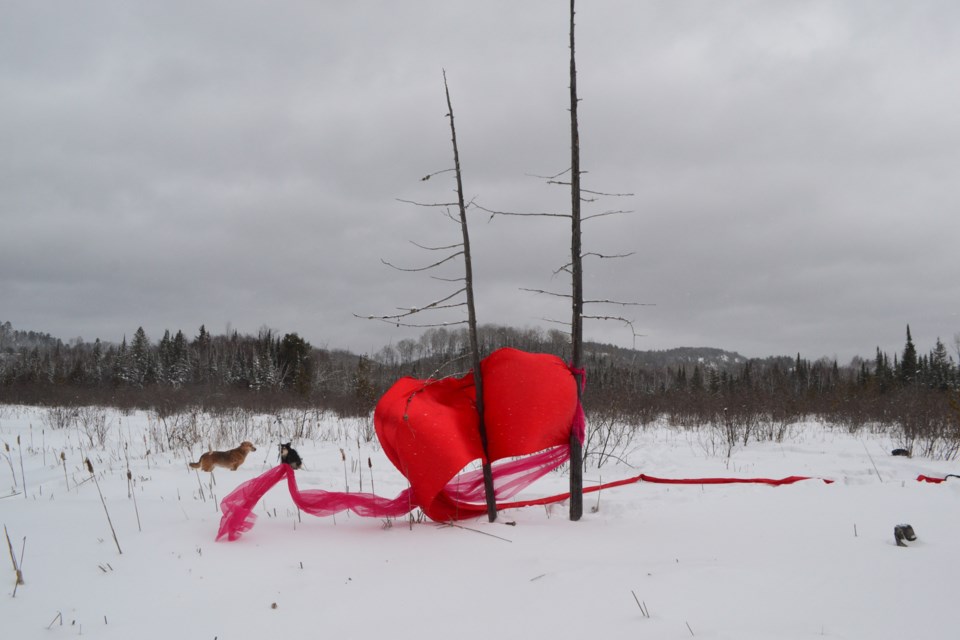For years now, artist Brit-Marie Lindgren has been hiking and snowshoeing across Algoma, placing and photographing long pieces of shimmering fabric across the natural landscape.
Funny enough, for her, it all started in a hippy “squat village” just outside Amsterdam almost 40 years ago.
Lindgren was one of several Algoma University BFA honours students who were part of an end-of-program exhibition that opened at the Art Gallery of Algoma Thursday Evening.
Lindgren’s project was a video of her hanging long strips of colourful cloth around Rock Lake, near her home in Leeburn just north of Echo Bay.
 Britt-Marie Lindgren showcased her video 'Earth Weavings' along with the works of other Algoma University BFA honours students at the Algoma Art Gallery on Thursday. Jeff Klassen/SooToday
Britt-Marie Lindgren showcased her video 'Earth Weavings' along with the works of other Algoma University BFA honours students at the Algoma Art Gallery on Thursday. Jeff Klassen/SooTodayLindgren has been working in this style for years.
She has amassed hundreds of photos on her laptop of she and those that help her hanging fabric on billion-year-old rock structures, snow-covered marshes, and through trees and other elements of the natural environment that inspire her.
The roots of it actually trace back to 1979 when at the age of 26 she moved to the Netherlands to attend an art academy.
Shortly after arriving there she started hanging out and working in the Ruigoord artist-colony or “squat village” that had recently sprung up in abandoned buildings just outside Amsterdam.
Although throughout the 1980s and 1990s she worked primarily with bronze and stone materials — often at Ruigoord — Lindgren said she can trace her interest in fabric-focused work to back to that time as well.
She recalls being interested in Germans who travelled to Ruigoord and set up frame and fabric structures to sleep in.
Lindgren said at Ruigoord she would work on projects like making flags, hanging Japanese prayer cloth on dead trees as part of a dance-related performance, and making ‘wrap' or 'fire' sculptures — chicken wire frames with straw that were wrapped in cloth and then burned during full moon ceremonies.
“This type of celebration of land (like is in her art) is what we did in our land festivals in Ruigoord,” said Lindgren.
In 2008 Lindgren moved back to Canada and with her new partner moved to the tiny village of Leeburn, 38 km east of the Sault, however, she still frequents the Netherlands on a regular basis.
In fact, Lindgren sources her fabric from a hundreds-of-year-old fabric market in Amsterdam where she says she can haggle down the price of quality textiles that would sell for at least three times the price here, if one could actually find them at all.
Her work currently involves three pieces of differently coloured 25-meter-long 'bridal fabric'-style cloth.
She will often place the fabric in places she is familiar with – like the marsh behind her home.
“I heard from the neighbor that one of the former owners of (my) property actually went bankrupt trying to drain the marsh. I thought, what a ridiculous project. These marsh areas are extremely important for nature (and) the planet. Human beings are coming into these types of areas and draining them (but) we need to respect and preserve these lands,” she said.
While Lindgren has been snowshoeing and hiking with her fabrics for years, her work at Algoma University this year is the first time she has attempted video.
She said it was a pretty steep learning curve — her first video attempt she held the camera sideways and the image kept focusing in and out.
"Britt’s work, the site is not simply a subject, but becomes a partner in developing the work. Elements of the land, and particularly those unseen forces like the wind, determine the shape and form of the work," reads an accompanying exhibition written statement.
Moving forward, Lindgren said she might try and shift the focus of the art work more towards environmental concerns.
“I’m considering expanding it to be more focused on ecological issues now (and thinking about) how I can now continue this project focusing on the ecological concerns up north. It’s about using art to pay attention to these precious areas on the planet,” she said.
Lindgren’s work, and that of the other thesis students, will be on display at the Art Gallery of Algoma until May 28.
